Aberdaugleddaw ![]()
John Anderson OO gauge 4mm scale
Aberdaugleddaw takes its inspiration from the area crossed by the lines to Milford Haven, Pembroke Dock and Fishguard Harbour. It takes features from each line in an attempt to recreate a terminus at the end of the line from Paddington via Swansea.
The start of the last decade of the 20th century was a time for change in west Wales with the loss of direct services to London and radical changes in the parcels and freight areas. Aberdaugeddlaw, although losing its daily HST to London, still retains newspaper and mail trains with an improved Sprinter service to Swansea, Cardiff and beyond. Freight is buoyant with a revitalisation of the dock area to servie the import and export of steel products. The MoD also has a strong presence with two depots on the Aberdaugeddlaw branch. Although not seen at the terminus itself, oil trains still move huge tonnages from the west Wales refineries and a new flow of coal has begun using a redundant refinery wharf. Locomotives from these workings are seen regularly stabled at Aberdaugeddlaw.


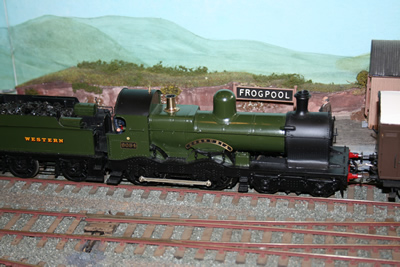
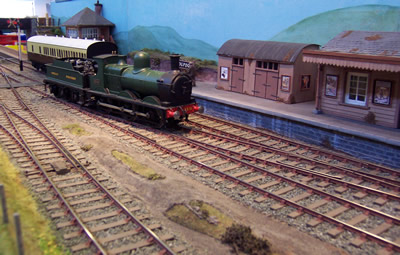
![]() Frogpool more photos
Frogpool more photos
Andover MRC O gauge 7mm scale
A highly fictitious and improbably small GWR terminus, somewhere between Falmouth and Truro. The village of Frogpool actually exists but in reality was never served by the railway. The layout was built by club member Tony Collins as an exercise in minimum space and is featured in the first Gauge O Guild book of small layouts published a few years ago.
The buildings are based on the following prototypes: station on Adelstrop plans from GWR Country Stations by Chris Leigh; signal cabin on Burghclere from a photograph in Didcot, Newbury and Southampton Railway by Kevin Robertson and Roger Simmonds; large lamp room and store on Tetbury from plans; lamp hut on Lambourn from plans; goods shed on Hemyock from photographs; bridge on Fairford from photographs, all these in Great Western Branch Line Termini by Paul Korau. Other items based on no particular prototype.
Gilbert Junction ![]()
Chris Hopper HO gauge 3.5mm scale
Gilbert Junction is a US HO switching layout using Kadee couplers for 'hands-off' operation and Peco US code 83 track.
The layout represents the 1950s Bosten and Maine Railroad with passenger, freight and milk trains. The main industry is a dairy and there is a branch line interchange yard and a track to an off-stage paper mill. Many of the freight cars are resin kits and some of the locos are repainted. Many of the structures are scratch-built. The layout is operated on DC but has been used successfully with a DCC system.
Other US railroads and periods make occasional appearances on the layout. The operators are always happy to discuss the layout, US rail-roading and modelling and - occasionally - DCC operation.
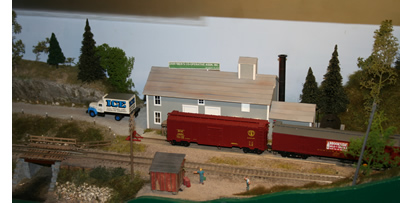
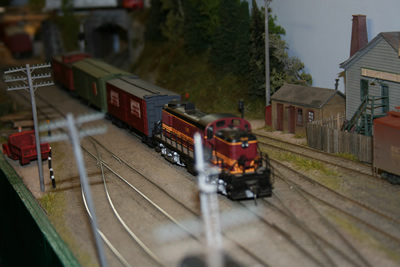
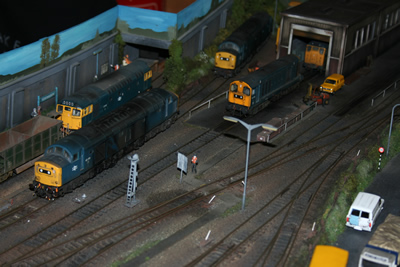
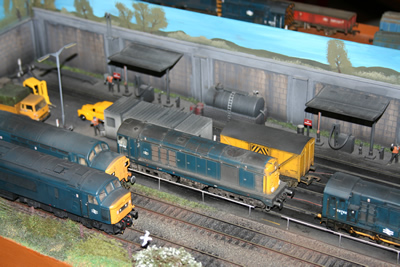
![]() Kirkbridge
Kirkbridge
Les Williams OO gauge 4mm scale
Kirkbridge is a small traction motive depot (TMD) set in the Glasgow suburbs. The TMD has a small halt station which sees a local DMU service and parcel trains.
It is set in the mid-seventies when British Rail blue livery rules the rails. There is a a range of locomotive classes: 06 and 08 shunters, plus many main line class 20, 24, 25, 26, 27, 31, 37, 40, 47 and class 55 Deltics.
The layout also has a small depot shed with two fuel points, and carries out repairs to carriages and wagons.
Limesbridge ![]()
Margaret & Paul Garratt OO gauge 4mm scale
This was the first exhibition for Limesbridge. The layout is intended to depict the atmosphere that was around a GWR station during the 1930s. Being fictitious, it allows the use of modellers' licence in creating something that depicts a rural location.
The station forms a junction where passenger trains arrive from the main line to connect with trains for the local branch. Freight trains can either terminate or pick up/drop off wagons and then make their way up the branch.
This layout was built with exhibiting in mind so the baseboards are of an easily manageable size and it can be erected/dismantled quickly and safely. The size of the layout with a large fiddle yard allows us to run longer trains using a variety of rolling stock.
Track work is SMP with hand built pointwork operated with Peco motors. The buildings are mainly from card or plastic kits either as designed or modified to suit. Rolling stock is a mixture of proprietary and kit built, all vehicles would have been seen on the GWR in the 1930s even if they never reached a small station like this.
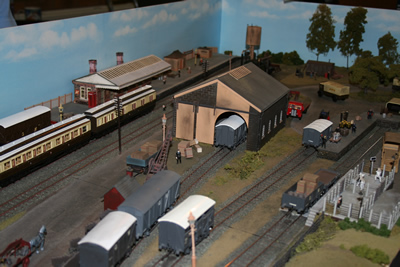
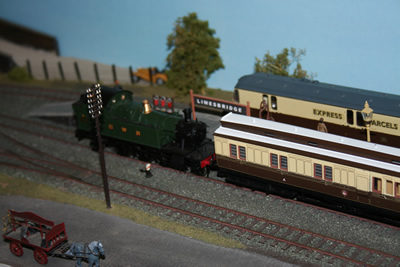

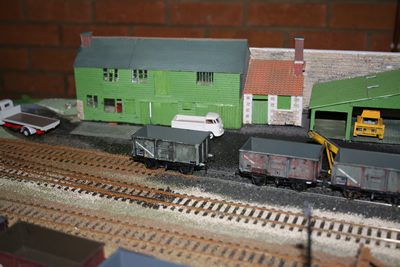
![]() Mortimore's Yard
Mortimore's Yard
Adrian Full OO gauge 4mm scale
Mortimore's Yard is a small fan of sidings where trains are assembled and split as their wagons make their way from and to customers' sidings in the nearby docks area. Set on an embankment, closely surrounded by a mix of housing and industry, the Yard represents a typical minor railway installation that operated for over 100 years, virtually unnoticed.
But traffic is declining, things are becoming run-down and neglected. Will Mortimore's Yard last much longer than the Western Region's distinctive diesel hydraulic locomotives, themselves under a sentence of death?
Although a fictional location, inspiration has come from many real places. The firm from which the layout takes its name ran a coal merchant's business based in Chippenham station yard for many years. Their former offices still stand as a listed building and are modelled. Similarly, other buildings on the layout are modelled on structures in the Chippenham area, some of which are now but a memory.
The layout features Digital Command Control using a Lenz 90 unit, and a mix of RtR and kit built rolling stock, with some major conversions and scratch built stock planned.
Nictun Borrud WEBSITE ![]()
Fareham & District MRC OO gauge 4mm scale
Nictun Borrud is set somewhere in the rolling chalk downland of the Hampshire Downs. It represents the terminus of a small branch line with some freight facility and is set in the late steam / early diesel period. The layout is built to finescale OO standards and features Southern Region.
The layout is intended as a fairly close representation of what might have existed at Southwick if the US Army Transportation Corps had had their way and built a branch line to allow the Allied Heads of Government and Defence Chiefs meeting to take place at the SHAPE headquarters in HMS Dryad. In the event, the meeting took place aboard the LMS Royal Train which was parked in the goods yard at Droxford for the duration. It is likely that this line would have left the Mean Valley line just south of Soberton village. But if it represents Southwick, why is it called Nictun Borrud? Well, as the original board was scavanged, the crew decided to continue this way of working and almost everything on the layout has been either 'nicked' or 'borrowed' from other projects or members' bit boxes. Hence the name, Nictun Borrud.
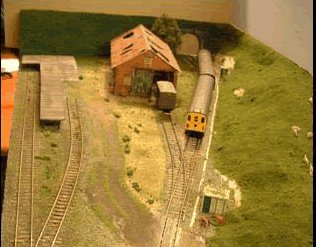
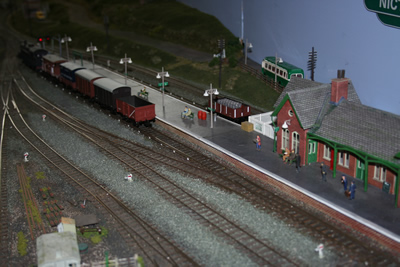
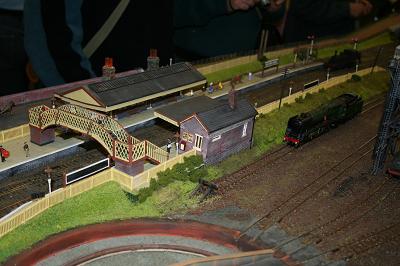
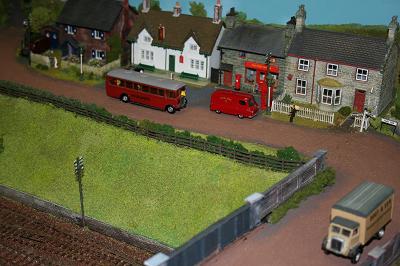
![]() Packwood Bridge
Packwood Bridge
David Boot & Joshua Hall OO gauge 4mm scale
The layout is designed to be multipurpose. It has a minimum size of 9’ x 2’-6" plus a fiddle yard which depicts a terminus made possible by the closure of the through line. However, the through line can be restored by the addition of two further scenic sections and the use of the fiddle yard from our Knowle Bridge layout. The layout can be displayed from either side, enabling the layout to have a different perspective each show. The idea was to be able to run locomotives at home without taking up too much room but to have a decent size layout for exhibitions.
The layout itself is based on Great Western practice during the 1950’s thus enabling locomotives from other regions to be found stabled in the engine shed. It also gives flexibility for locomotives with pre BR numbering to be seen depending on which end of the 50’s is run.
The track is SMC with Peco code 75 points. Generally the railway and buildings are scratch-built using bits from various kits and the cooling tower is the Ratio kit. Domestic properties and shops are from the Skaledale range suitably modified. Signals are Ratio and MSE kits. There is a working turntable built into the yard, again scratch-built to GWR design, which was given to me by a lady whose husband had sadly passed on.
Locomotives and rolling stock are usually ready-to-run items with fine detail added and the odd one or two kit built ones. When the layout is at its maximum, the locomotives and coaching stock are supplemented by the excellent kit built stock from the Rob Newman stable.
Tan-y-Bwlch ![]()
Angus Watkins OO9 gauge 4mm scale
Tan-y-Bwlch is an important passing place about halfway along the mainly single track Festioniog Railway. Its loop allowed long slate trains, running down to Portmadoc under gravity alone, to pass equally long loco-hauled mixed trains taking passengers and empty slate wagons up to Blaenau Ffestioniog.
The layout attempts to portray Tan-y-Bwlch station in the early 1900s before the station building was extended to make a dwelling house for the station master and the aim is to show one full day's running on the Festiniog Railway at that time. There are quarrymen's trains, gravity slate trains, passenger trains and mixed trains passing through and crossing.
The buildings, trees and walls are scratch-built. The track, except for one point, is Peco. The stock is a mixture of kits and scratch building and illustrates attempts to model Festiniog vehicles over a span of some 40 years. Some vehicles are real 'heritage' items!
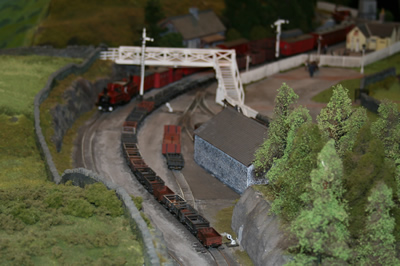
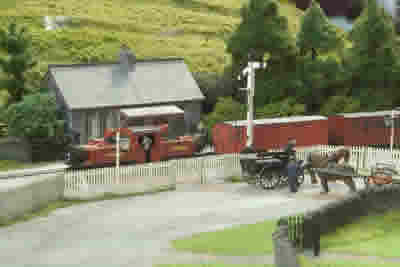
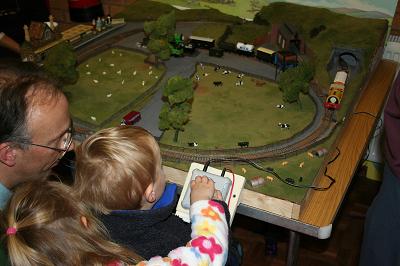
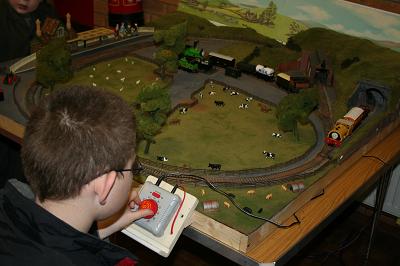
![]() Thomas more photos
Thomas more photos
Hucclecote Model Railway Enthusiasts OO gauge 4mm scale
We would like to thank Trevor Hallam for looking after the Thomas Layout for many years at our exhibitions and also for refurbishing it at his expense.
Unfortunately because of ill health Trevor is no longer able to continue so it was decided to offer Thomas free of charge to Hucclecote Railway Modellers on condition they bring it to all of our future exhibitions.
This is the model railway where Children can become Engine Drivers on the Island of Sodor and has of course been inspired by the Reverend Audrey books.
Our Thomas and Friends layout has been built for ten years now and in that time we hope it has encouraged many new railway enthusiasts to build a train set of their own.
Originally it was intended as a space filler at shows so needed to be small, easy to transport and have a simple track plan, easy for small children to operate.
After its first appearance it was clear this model railway would have to be included at all our exhibitions.
It incorporates a tunnel, station, level crossing together with locomotive and goods facilities. Train drivers should look out for many of the popular characters; Henry, Percy, Toby, Cranky, the Troublesome Trucks, not forgetting the Sir Topham Hatt better known as the Fat Controller.
The famous anthropomorphised rolling stock is mostly from the Thomas range and we are sure most of the adults and all the kids will love it.
Happy Driving, but please observe the track speed limits.
Ffestiniog Railway WEBSITE ![]()
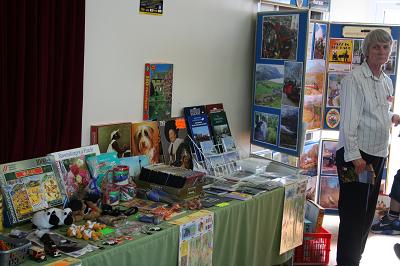
Model Bus Federation WEBSITE ![]()
Paul Mellor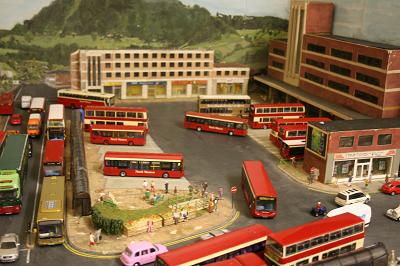
NARTM (road transport) WEBSITE ![]()
David Mellor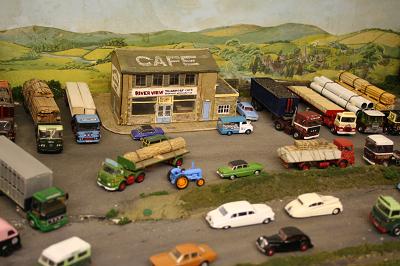
Travel 2000 Ltd ![]()
Andy Peckham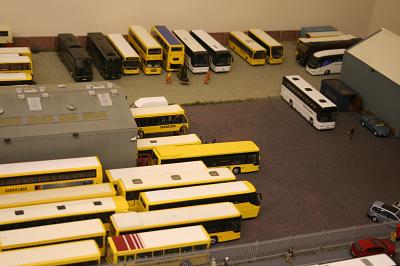
Kaiser Bill's Airforce WEBSITE
Alan Drewett